Spies everywhere: Inkognito the board game
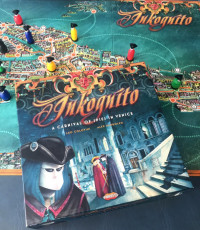
Earlier this year, we posted our review of Inkognito the card game. It’s a quick deduction game we really enjoy.
At the end of our review, we mentioned Inkognito the board game but couldn’t share our take on it because we’d never played it.
But, that was then…
Thanks to Ares Games sending us a copy of Inkognito the board game this summer, we’re happy to now post our review of this great deduction game as well.
How to play Inkognito
The first thing we should note is that this is a new version of Inkognito. The original was published in 1988 and the reimplemented 2013 version by Ares Games.
Objective
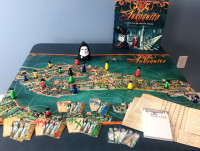
In Inkognito, players take on the role of spies in Venice during Carnival. The goal of each agent is to complete a mission together with his or her partner.
The catch is that at the first of the game, no one knows who their partner is nor what their mission is. So players must first discover who their partner spy is, then they must accomplish their mission.
The first pair of spies to complete their mission wins the game.
It’s a great premise for a deduction game and one that’s executed really well in Inkognito.
Set Up
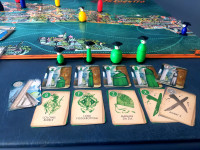
At the start of the game, players each player takes a set of 4 colored Identity cards and 4 colored Build cards (red, green, blue, yellow). They also take the 4 character figures of that color, a note sheet, and 1 passport (shield to note their findings).
Every secret agent has 4 possible physical builds, which are represented by their 4 figures (short, tall, skinny, fat).
There are 4 spaces of each color marked on the board. Those are the starting spots for the associated colored figures and each player chooses which of their figures to place on their colored spots.
The Ambassador figure is placed on his starting spot – the Embassy (black circle). And the Phantom of Prophecy is also placed in the lagoon or near the board.
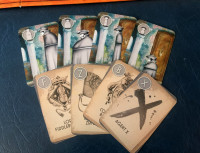
Once everything is set up, players receive their secret identity:
There are 12 grey cards in three groups (identity, build, and mission). Each player is secretly dealt 1 of the 4 identity cards, 1 of the 4 build cards, and 1 of the 4 mission cards.
Thus everyone now knows their own Identity, Build, and half of their Mission and are ready to start playing.
Playing the Game
There are two parts to every player’s turn: Movement and Meeting Characters/Asking Questions.
Movement:
This is where the cool Phantom of Prophecy comes into play. Inside the Phantom of Prophecy are 10 balls – 2 of each color.
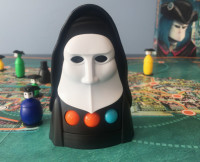
The player ‘vigorously’ shakes the Phantom of Prophecy and sets it down so that 3 balls will appear in the 3 openings at the base of the phantom. The colors that appear determine how the player can move figures around the board.
- Orange: May move one of their figures one space on a land route (orange lines).
- Blue: May move one of their figures one space on a water route (blue lines).
- White: May move one of their figures one space on either a land or a water route.
- Purple: May move one opponent’s figure one space on either a land or a water route.
- Black: May move the Ambassador figure one space on either a land or a water route.
Note that a player “may” move, but isn’t required to use all three movement actions.
Players can use their movements in any combination they’d like such as 1 figure 3 spaces or 3 figures 1 space each, or any combination. The only restrictions are they they can’t end a movement with 2 of their own figures on a space nor can they end such that they’re sharing spaces with more than 1 figure of a single opponent.
Also, when moving the Ambassador or another player’s figure, those figures can’t end movement sharing a space with a figure of another player.
The strategy during movement is to meet up with players you need to find information from.
Meeting Characters/Asking Questions:
This is the stage where your deductive skills will come into play.
After moving figures, if your figures are sharing spaces with other figures, you can Ask Questions. If two or three of your figures are sharing spaces with other figures, you get to ask each of those characters questions as well.
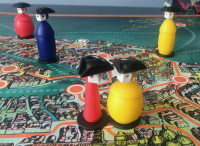
To Ask Questions, you get to see 3 of that player’s cards.
You can ask about their Identity. In which case that player must secretly show you 2 of their Identity cards and 1 of their Build cards.
Or you can ask about their Build. In which case that player must secretly show you 2 of their Build cards and 1 of their Identity cards.
In either case, at least 1 of the 3 cards shown must be true.
If a you meet up with the Ambassador, you may request to see either 2 Identity cards or 2 Build cards of any player you wish. In which case, 1 of the 2 cards must be true.
Once you have received information during the question stage, make notes on your special (and hidden) note pad. The rules suggest ways to keep notes – about which cards you’ve seen from which players as well as which cards you’ve shown other players. They’re good suggestions, but you can really keep notes however you’d like.
Once you’ve asked questions of that other player, you get to move their figure to any unnumbered and unoccupied space on the board. After meeting with the Ambassador, you move his figure back to the Embassy.
If you don’t need any more information from that player, you can skip asking questions and move an extra space.
Finding your partner and completing your Mission
Pretty soon you’ll figure out the true identities and builds of the other players so you can deduce who your partner is.
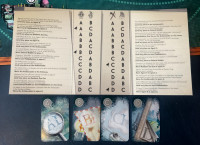
The partnerships are always Lord Fiddlebottom with Colonel Bubble and Agent X with Madame Zsa Zsa.
Once you know who your partner is and their true identity, you’ll want to reveal yourself to them. If you’re certain, one way you could do this is by showing them your Mission card the next time you get to show cards to them.
The reason partners need to show each other their respective Mission cards is because that’s how they find out what their secret mission is.
This is a pretty cool mechanism in the game.
There are 24 possible missions in the game and they’re listed inside the passports for reference. Which mission you have to complete is totally dependent on who you are and which mission card combination you and your partner have.
For example, if you’re Agent X and have Mission card C and your partner, Madame Zsa Zsa has Mission card D, then to win, you’ll need to get your true Agent X character to space 2. This means that if your true character is Short of Build, then you’ll need to get your short figure to space 2.
However, if your partner has Mission card A, then your collective mission is to land on any space with the true Colonel Bubble character (his colored figure representing his true Build).
It’s a pretty cool system of deduction as well as determining what to reveal to other players and when to do so.
And it’s really fun.
Playing with 3 or 5 players
This new version of Inkognito allows for the addition of a 5th player who plays the role of the Ambassador. Since, the 5th player doesn’t have a partner to meet, he/she has a unique way of winning.
To win, the Ambassador needs to find out the true Identity and Build of every other player before any of the pairs complete their mission.
Of course, there are also special rules that come into play when the Ambassador is controlled by a player.
The Ambassador doesn’t use the Phantom of Prophecy to move. Instead, they can move the Ambassador figure once or twice on either land or water routes. When meeting up with other characters, the Ambassador gets to see either 2 Identity cards or 2 Build cards of that player (1 of the 2 cards must be true).
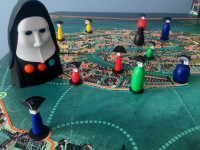
Like in the regular game, after questioning a player, the Ambassador sends that figure to any unnumbered and unoccupied spot in Venice.
During other players’ turns, if a player uses the Ambassador figure to ask questions of another player, the questioned player must pass the chosen cards to the Ambassador first. Thus, the Ambassador player gets information every time he’s used in questioning.
With 3 players, one of the players won’t have a partner.
This means that their partner has been captured and is being questioned. So that player must escape Venice as soon as they can in order to win.
At the start of the game, all figures, cards, and passport of one color is removed from the game.
The game play is completely the same except for the Mission stage. Through questioning, one of the players will discover that their partner is the one not in play.
If that player is you, then your mission is to leave Venice through your designated spot. There are 4 running man icons inside the passport. Locate the one where your character is listed and get your true figure on the board to that spot to win.
If you do have a partner, then move quickly to complete your joint mission for the win.
What we think of Inkognito the board game
We love playing deduction games in our family. We love the challenge of trying to figure things out. And deduction games have especially been fun once our kids started giving us a run for our money as well.
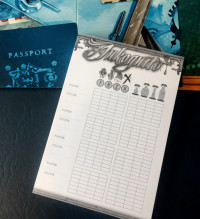
Playing strategy games and deduction games when they were little definitely has had great benefits in this regard. It’s been great seeing their reasoning skills develop as they’ve grown.
And losing a deduction game to a child isn’t necessarily a downside either. In fact, it can be kind of rewarding. (At least for a little while.)
Inkognito hits the mark on being a great deduction game.
It’s almost like a double-deduction game because of the two step process in discovering your partner and then finding and completing your mission.
One thing we learned the hard way though is to make sure it’s clear at the outset that when completing your mission, you make sure you’re doing so with the real character figure on the board.
Trevor made this mistake in our first play of Inkognito.
I was Lord Fiddlebottom and he was my partner, Colonel Bubble. Our mission was to land any piece on Agent X and he gave me the confident smile that he was ready to complete our mission.
The only problem was that he hadn’t figure out the true identity of Agent X. He knew that Agent X was the green player, so when it was his turn, he moved a figure to share a spot with a green figure (the Tall one) and proudly announced that we had completed our mission!
However, what Trevor had forgotten was that we had to land on the green figure that was the true identity of Agent X.
So after our high-fives, the player controlling green proudly announced that he was in fact Agent X, but that his Build was Skinny and thus, we had not actually completed our mission, therefore he and his partner won. Major bummer!
It was definitely a learning experience. But it was also a hilarious experience capping off a very fun game of intrigue.
So it turns out that we like both versions of Inkognito – the board game and the card game. If we’re looking for something that plays more quickly, we’ll take the card game. But if we’re up for a bit more thinking and challenge, we’ll reach for the board game.
What we think of 5 players
While we haven’t played with 3 players yet, we have played with 5 players. And the verdict wasn’t positive. Yes, it allows more to be a part of the experience. But because of the extra benefit the Ambassador gets, most players didn’t try to question players using the Ambassador figure.
Even when it’s not your turn, you’re still mentally engaged in the game. While other players are taking their turns, you’re able to think through what you know as well as see what other players are trying to figure out. In addition, another player may meet up with your character and you’ll have to think through which cards to show him. All of this means that there doesn’t feel like a lot of down time during the game.
That is, except for the Ambassador. If people aren’t using the Ambassador figure when playing with a 5th player, then the Ambassador player does in fact have a lot of down time. It may be easier for him to discover identities because he gets to see 2 cards when he questions someone. But since he may only be seeing cards when it’s his turn, he doesn’t have a lot to think about when it’s not his turn.
So if we have 5 players and want to play a deduction game, we’ll reach for another one of our favorite deduction games like Code 777 or Scotland Yard.
How does Inkognito score on our “Let’s Play Again” game meter?
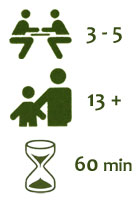 The board game version of Inkognito scores high our our “let’s play again” game meter.
The board game version of Inkognito scores high our our “let’s play again” game meter.
Like I mentioned before, we really like deduction games. While they may not be filled with a lot of joviality and laughter, when we’re in the mood to puzzle things out, they’re really enjoyable.
But because of the mental challenge, we don’t often play a deduction game multiple times in a row.
However, even though we may not play games of Inkognito back-to-back, when the game ends, we leave highly anticipating the next time we’ll play.
Thanks Ares Games for a fantastic deduction game!


